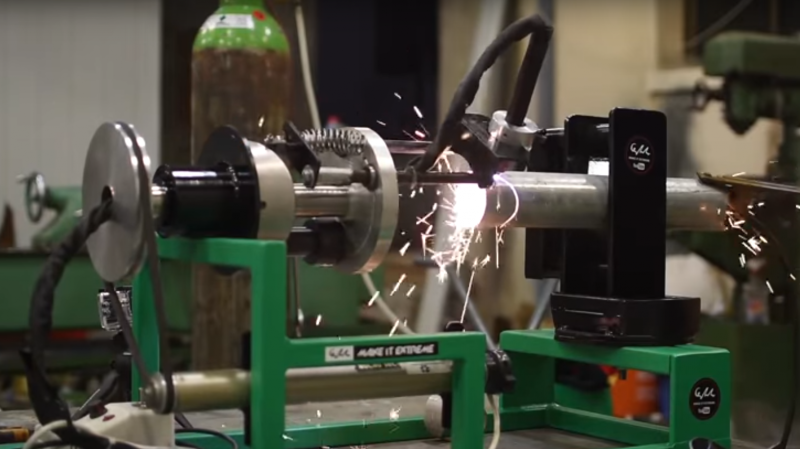It may be [MakeItExtreme]’s most ambitious build to date. There are a lot of moving parts to this plasma cutter tubing notcher, but it ought to make a fine addition to the shop and open up a lot of fabrication possibilities.
We have to admit to a certain initial bafflement when watching the video below for the first time. We can usually see where [MakeItExtreme]’s builds are going right from the first pieces of stock that get cut, but the large tube with the pressed-in bearing had us scratching our heads. The plan soon became clear — a motorized horizontal rotary table with a hollow quill for the plasma torch leads. There’s a jig for holding the torch itself that can move in and out relative to the table. Cams made of tube sections can be bolted to a fixed platen; a cam follower rides on the cams and moves the torch in and out as the table rotates. This makes the cuts needed to properly fit tubes together — known as fish mouth cuts or saddle cuts. The cams can be removed for straight cuts, and the custom pipe vise can be adjusted to make miter cuts.
All in all a sturdy and versatile build that ought to enable tons of new projects, especially when teamed up with [MakeIt Extreme]’s recent roll bender.















I want to build one of these! I’m glad someone has gone to the effort :)
Awesome!!!!
Their workshop must be bulging at the seams with all of the awesome tools these guys are making.
My favourite part is the cam. Most makers would put an Arduino on it and this is so elegantly analog.
Loud music, filmed with a decent and steady camera, showing: lot’s of metal, sparkles, electric motor and lot’s of power tools… Always cool!
Having just painstakingly cut notches out of some tubing the slow / low tech way (draw the curve on with a marksall and then cut away everything inside the marketed area with an angle grinder) and despite my steadiest hand the fit was less than perfect, I can definitely see the appeal of a jig for doing this sort of thing.
I just pooped my pants!
miter cuts look like they are a bit problematic, the plasma cutter only moves in a circle, and if the pipe is at an angle, the pipe is not a circle. At shallow angles with a straight cut they can get away with it, but try to do a fishmouth on a pipe at 45 degrees and you will find that you need to move the plasma cutter radially, not just rotationally.
Couldn’t you use your mitered cuts to generate jigs that are accurate on-axis (particularly with thin wall material to lessen the distortion)? That was my first thought too, but I think it may be a self-correcting problem with a little bit of forethought.
It’s just begging for a CNC upgrade! A few steppers and some software and you could add a whole lot of flexibility.
This is an amazing jig. That cable twist though! /cringe.
Gah! I want!! I’m heading into a pipe-and-rail project with 72 coves to cut by hand with an Oxy-Propane torch.
Sharpen the saw, build a jig like this first. Shouldn’t be hard and makes life SO much easier
“a motorized horizontal rotary table”. Or what most people would refer to simply as a spindle or indexing head/unit :).